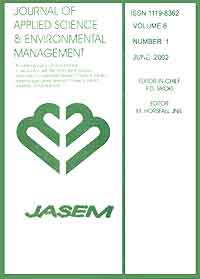
|
Journal of Applied Sciences and Environmental Management
World Bank assisted National Agricultural Research Project (NARP) - University of Port Harcourt
ISSN: 1119-8362
Vol. 18, No. 4, 2014, pp. 677-683
|
 Bioline Code: ja14090
Bioline Code: ja14090
Full paper language: English
Document type: Research Article
Document available free of charge
|
|
|
Journal of Applied Sciences and Environmental Management, Vol. 18, No. 4, 2014, pp. 677-683
| en |
Characterization of Soil and Sediment Parameters of Jisike-Izombe Upper Aquifer System for Assessment of the Potential of Groundwater Pollution
S. ONYEOBI, T.U. & AKUJIEZE, C.N.
Abstract
The JES field, an onshore field in the Jisike – Izombe area of southeastern
Nigeria had a number of oil-producing wells before it was abandoned over a decade ago.
By means of soil/sediment samples retrieved from three strategically located boreholes
around the field, the subsurface units were delineated and the physical characteristics of the
vadose zone were determined in order to predict the groundwater pollution potential of the
upper aquifer system in the area. Ground conditions were found to be approximately 1metre
(3.043ft) of loamy top soil overlying about 1.2metres (3.65ft) of clayey laterite which
overlies 19.4 – 24.6metres i.e (60ft – 75ft) of reddish-brown silty sand, beneath which is
medium – coarse grained white sand which constitutes the aquifer system with estimated
hydraulic conductivity in the range 1 x 10-1 to 169 x 10-1 mm/sec. Flow analysis of
groundwater indicates a southwesterly flow with the River Niger as possible discharge
zone. The high leaching potentials and high transmissive properties of the sediments below
the clayey laterite suggests a vulnerability of the aquifer to pollution through vertical
infiltration. However, borehole water quality parameters for the area show that groundwater
quality is not in anyway compromised when compared to the WHO limits. Rather, it is
argued that the groundwater is naturally well protected by the upper part of the vadose zone
where the clayey lateritic soil with iron oxide cementation of soil particles provides an
appreciable degree of barrier to downward movement of contaminants. Because of the
clayey behavour of the near-surface soils and their affinity for the retention of
contaminants, it is concluded that the area is not a locus of groundwater pollution.
|
| |
© Copyright 2014 - Journal of Applied Sciences and Environmental Management
|
|
